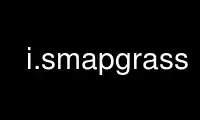
This is the command i.smapgrass that can be run in the OnWorks free hosting provider using one of our multiple free online workstations such as Ubuntu Online, Fedora Online, Windows online emulator or MAC OS online emulator
PROGRAM:
NAME
i.smap - Performs contextual image classification using sequential maximum a posteriori
(SMAP) estimation.
KEYWORDS
imagery, classification, supervised classification, segmentation, SMAP
SYNOPSIS
i.smap
i.smap --help
i.smap [-m] group=name subgroup=name signaturefile=name output=name [goodness=name]
[blocksize=integer] [--overwrite] [--help] [--verbose] [--quiet] [--ui]
Flags:
-m
Use maximum likelihood estimation (instead of smap)
--overwrite
Allow output files to overwrite existing files
--help
Print usage summary
--verbose
Verbose module output
--quiet
Quiet module output
--ui
Force launching GUI dialog
Parameters:
group=name [required]
Name of input imagery group
subgroup=name [required]
Name of input imagery subgroup
signaturefile=name [required]
Name of input file containing signatures
Generated by i.gensigset
output=name [required]
Name for output raster map holding classification results
goodness=name
Name for output raster map holding goodness of fit (lower is better)
blocksize=integer
Size of submatrix to process at one time
Default: 1024
DESCRIPTION
The i.smap program is used to segment multispectral images using a spectral class model
known as a Gaussian mixture distribution. Since Gaussian mixture distributions include
conventional multivariate Gaussian distributions, this program may also be used to segment
multispectral images based on simple spectral mean and covariance parameters.
i.smap has two modes of operation. The first mode is the sequential maximum a posteriori
(SMAP) mode [1,2]. The SMAP segmentation algorithm attempts to improve segmentation
accuracy by segmenting the image into regions rather than segmenting each pixel separately
(see NOTES).
The second mode is the more conventional maximum likelihood (ML) classification which
classifies each pixel separately, but requires somewhat less computation. This mode is
selected with the -m flag (see below).
OPTIONS
Flags:
-m
Use maximum likelihood estimation (instead of smap). Normal operation is to use SMAP
estimation (see NOTES).
Parameters:
group=name
imagery group
The imagery group that defines the image to be classified.
subgroup=name
imagery subgroup
The subgroup within the group specified that specifies the subset of the band files
that are to be used as image data to be classified.
signaturefile=name
imagery signaturefile
The signature file that contains the spectral signatures (i.e., the statistics) for
the classes to be identified in the image. This signature file is produced by the
program i.gensigset (see NOTES).
blocksize=value
size of submatrix to process at one time
default: 1024
This option specifies the size of the "window" to be used when reading the image data.
This program was written to be nice about memory usage without influencing the resultant
classification. This option allows the user to control how much memory is used. More
memory may mean faster (or slower) operation depending on how much real memory your
machine has and how much virtual memory the program uses.
The size of the submatrix used in segmenting the image has a principle function of
controlling memory usage; however, it also can have a subtle effect on the quality of the
segmentation in the smap mode. The smoothing parameters for the smap segmentation are
estimated separately for each submatrix. Therefore, if the image has regions with
qualitatively different behavior, (e.g., natural woodlands and man-made agricultural
fields) it may be useful to use a submatrix small enough so that different smoothing
parameters may be used for each distinctive region of the image.
The submatrix size has no effect on the performance of the ML segmentation method.
output=name
output raster map.
The name of a raster map that will contain the classification results. This new
raster map layer will contain categories that can be related to landcover categories
on the ground.
INTERACTIVE MODE
If none of the arguments are specified on the command line, i.smap will interactively
prompt for the names of the maps and files.
NOTES
The SMAP algorithm exploits the fact that nearby pixels in an image are likely to have the
same class. It works by segmenting the image at various scales or resolutions and using
the coarse scale segmentations to guide the finer scale segmentations. In addition to
reducing the number of misclassifications, the SMAP algorithm generally produces
segmentations with larger connected regions of a fixed class which may be useful in some
applications.
The amount of smoothing that is performed in the segmentation is dependent of the behavior
of the data in the image. If the data suggests that the nearby pixels often change class,
then the algorithm will adaptively reduce the amount of smoothing. This ensures that
excessively large regions are not formed.
The degree of misclassifications can be investigated with the goodness of fit output map.
Lower values indicate a better fit. The largest 5 to 15% of the goodness values may need
some closer inspection.
The module i.smap does not support MASKed or NULL cells. Therefore it might be necessary
to create a copy of the classification results using e.g. r.mapcalc:
r.mapcalc "MASKed_map = classification_results"
EXAMPLE
Supervised classification of LANDSAT
g.region raster=lsat7_2002_10 -p
# store VIZ, NIR, MIR into group/subgroup
i.group group=my_lsat7_2002 subgroup=my_lsat7_2002 \
input=lsat7_2002_10,lsat7_2002_20,lsat7_2002_30,lsat7_2002_40,lsat7_2002_50,lsat7_2002_70
# Now digitize training areas "training" with the digitizer
# and convert to raster model with v.to.rast
v.to.rast input=training output=training use=cat label_column=label
# calculate statistics
i.gensigset trainingmap=training group=my_lsat7_2002 subgroup=my_lsat7_2002 \
signaturefile=my_smap_lsat7_2002 maxsig=5
i.smap group=my_lsat7_2002 subgroup=my_lsat7_2002 signaturefile=my_smap_lsat7_2002 \
output=lsat7_2002_smap_classes
# Visually check result
d.mon wx0
d.rast.leg lsat7_2002_smap_classes
# Statistically check result
r.kappa -w classification=lsat7_2002_smap_classes reference=training
REFERENCES
· C. Bouman and M. Shapiro, "Multispectral Image Segmentation using a Multiscale
Image Model", Proc. of IEEE Int’l Conf. on Acoust., Speech and Sig. Proc., pp.
III-565 - III-568, San Francisco, California, March 23-26, 1992.
· C. Bouman and M. Shapiro 1994, "A Multiscale Random Field Model for Bayesian Image
Segmentation", IEEE Trans. on Image Processing., 3(2), 162-177" (PDF)
· McCauley, J.D. and B.A. Engel 1995, "Comparison of Scene Segmentations: SMAP, ECHO
and Maximum Likelyhood", IEEE Trans. on Geoscience and Remote Sensing, 33(6):
1313-1316.
Use i.smapgrass online using onworks.net services
